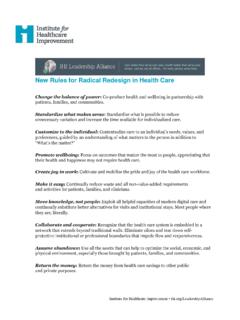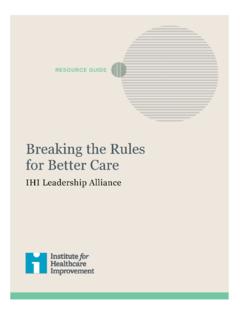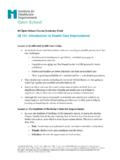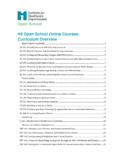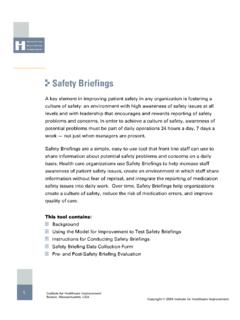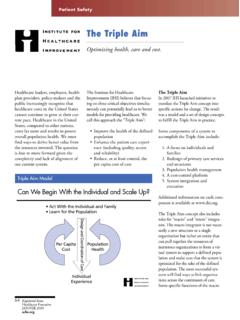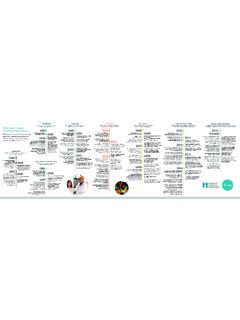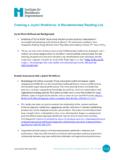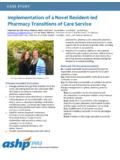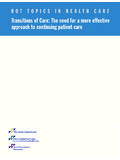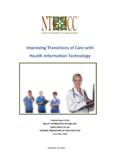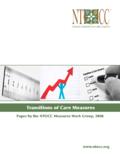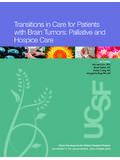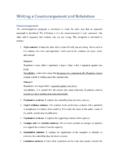Transcription of Improving Transitions from the Hospital to Post-Acute Care ...
1 Improving Transitions from the Hospital to Post-Acute care Settings to Reduce avoidable Rehospitalizations Institute for Healthcare Improvement - How-to Guide Summary Introduction This How-To Guide is designed to support Hospital -based teams and their community partners in co-designing and reliably implementing improved care processes to ensure that patients who have been discharged from the Hospital have an ideal transition home or to the next community care setting. Based on the growing body of evidence and IHI s experience to date in Improving Transitions in care after a hospitalization and reducing avoidable rehospitalizations, IHI has developed a conceptual roadmap (right) that depicts the cumulative effect of key interventions to improve the care of patients throughout the 30 days after patients are discharged from a Hospital or Post-Acute care facility.
2 The transition from the Hospital to Post-Acute care settings has emerged as an important priority in IHI s work to reduce avoidable rehospitalizations. Transitions in care after a hospitalization involve both an improved transition out of the Hospital (and from Post-Acute care and rehabilitation facilities) as well as an activated (ready for specified Transitions process) and reliable reception into the next setting of care such as a primary care practice, skilled nursing facility, or home care . Key Changes to Create an Ideal transition Home 1. Perform an Enhanced Assessment of Post- Hospital Needs A. Involve the patient, family caregivers, and community providers as full partners in completing a needs assessment of the patient s home-going needs. B. Reconcile medications upon admission.
3 C. Identify the patient s initial risk of readmission. D. Create a customized discharge plan based on the assessment. 3. Ensure Post- Hospital care Follow-up A. Reassess the patient s medical and social risk for readmission. B. Prior to discharge, schedule timely follow-up care and initiate clinical and social services as indicated from the assessment of post- Hospital needs. 2. Provide Effective Teaching and Facilitate Enhanced Learning A. Involve all learners in patient education. B. Redesign the patient education process. C. Redesign patient teaching print materials. D. Use Teach Back regularly throughout the Hospital stay to assess the patient s and family caregivers understanding of discharge instructions and ability to perform self- care . 4. Provide Real-Time Handover Communications A. Give patient and family members a patient-friendly post- Hospital care plan that includes a clear medication list.
4 B. Provide customized, real-time critical information to the next clinical care provider(s). C. For high-risk patients, a clinician calls the individual(s) listed as the patient s next clinical care provider(s) to discuss the patient s status and plan of care . Associated Process Measures Key Change Process Measures 1. Perform an Enhanced Assessment of Post- Hospital Needs Percent of admissions where patients and family caregivers are included in assessing post-discharge needs Percent of admissions where community providers ( , home care providers, primary care providers, and nurses and staff in skilled nursing facilities) are included in assessing post-discharge needs 2. Provide Effective Teaching and Facilitate Enhanced Learning Percent of observations of nurses teaching patient or other identified learner where Teach Back is used to assess understanding Percent of observations of doctors teaching patient or other identified learner where Teach Back is used to assess understanding 3.
5 Ensure Post- Hospital care Follow-up Percent of patients discharged who had a follow-up visit scheduled before being discharged, in accordance with their risk assessment 4. Provide Real-Time Handover Communications Percent of patients discharged who receive a customized discharge plan written in patient-friendly language at the time of discharge Percent of discharges where critical information is transmitted at the time of discharge to the next site of care ( , home health, long-term care facility, rehabilitation care , physician office) Where to Find Resources in the How-To Guide For more information, please see the full version of the How-To Guide: How-to Guide: Improving Transitions from the Hospital to Post-Acute care Settings to Reduce avoidable Rehospitalizations
